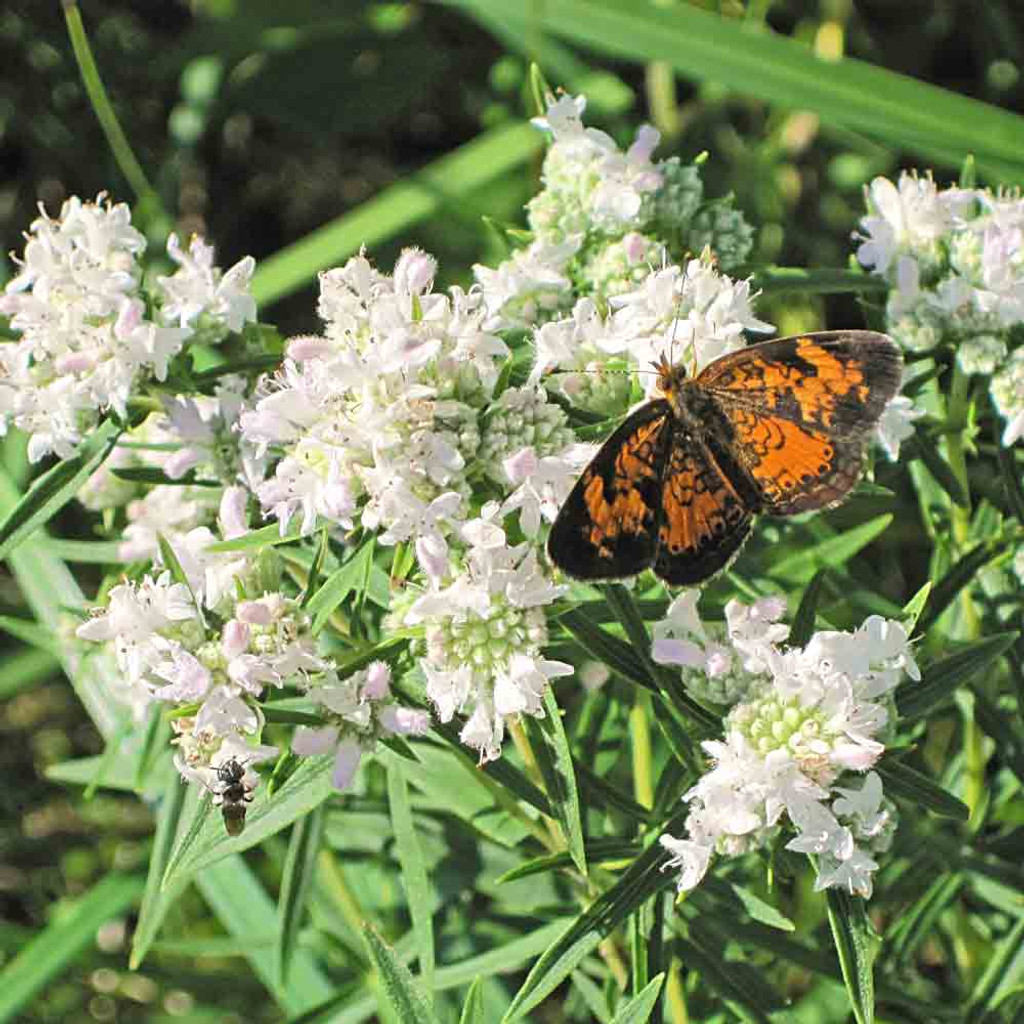
The root pattern is rhizomatous with underground stems sending roots and shoots along their length. The plant growth habit is a clumper with limited spread. and size shown above) information on the habit and root pattern is also useful and given here if available.


11-1 indicates that the plant is heat tolerant in zones 11 through 1.) For polyculture design as well as the above-ground architecture (form - tree, shrub etc. Heat Zones range from 1 (no heat days) to 12 (210 or more heat days).įor example Heat Zone. The Plant Heat Zone map is based on the number of "heat days" experienced in a given area where the temperature climbs to over 86 degrees F (30☌).Īt this temperature, many plants begin to suffer physiological damage. Plant Heat Zones show when plants would start suffering from the heat. (Plant Hardiness Zones show how well plants withstand cold winter temperatures. The plant is heat tolerant in zones 8 through 1.
Pycnanthemum virginianum full#
Available on the web at ( ).Succeeds in most soils but prefers a rich loamy soil in full sun or partial shade with plenty of moisture in the growing season. New York Flora Association, Albany, New York Cranbrook Institute of Science Bulletin 61 and University of Michigan Herbarium. Dicots Concluded (Pyrolaceae - Compositae). Additions, range extensions, reinstatements, and relocations in the New Jersey flora. University of Pennsylvania Press, Philadelphia, PA. The Plants of Pennsylvania, an Illustrated Manual. Newcomb's Wildflower Guide: An Ingenious New Key System for Quick, Positive Field Identification of the Wildflowers, Flowering Shrubs, and Vines of Northeastern and North-Central North America. New York Natural Heritage Program Databases. New York State Department of Environmental Conservation. The New York Botanical Garden, Bronx, New York. Illustrations of the Vascular Plants of Northeastern United States and Adjacent Canada. The Illustrated Companion to Gleason and Cronquist's Manual. University Of California Publications in Botany 20: 195-240. A Field Guide to the Northeastern United States. 910 pp.Ĭlemants, Steven and Carol Gracie.
Pycnanthemum virginianum manual#
Manual of Vascular Plants of Northeastern United States and Adjacent Canada. This species flowers in mid-July to early September, with the fruits persisting through the first frost.Īdditional Resources Best Identification Reference clinopodioides, have a bilabiate calyx, with the upper and lower calyx teeth of unequal lengths. Pycnanthemum muticum leaves are usually not more than 2 times as long as wide and range from 1 to 4 cm wide. verticillatum typically have leaves at least 3 times as long as wide, and only rarely over 1.5 cm wide. In New York misidentifications of Pycnanthemum muticum usually turn out to be P.virginianum, P. Best Life Stage for Proper Identificationīlunt Mountain-mint is best identified when flowering or fruiting. The teeth of the calyx are all triangular to acuminate (long-pointed). They are 2-lipped, the petals are white or pale violet with many purple spots. The flowers are crowded in rounded heads at the top of the stems. The middle stem leaves are typically glabrous to waxy above, while the upper inflorescence leaves are velvety. They range from 1 to 4 cm wide and are usually no more than twice as long as wide.

Robinson: Common Name: Virginia mountain mint: Habitat: Edges of marshes, fields, thickets, and railroad. These are broadly oval, with a pointed tip, and round or heart-shaped leaf bases. Pycnanthemum virginianum (L.) Durieu & Jacks. A main field characteristic of Pycnanthemum muticum is its firm, thick, dark green leaves. Like other Mountain-mints it is strongly aromatic, such that a strong spearmint odor from the leaves may be the explorer's first clue to its presence. Pycnanthemum muticum is a rhizomatous herb with a branching, pubescent, square stem up to 1 m tall. Identification Comments General Description Vaccinium corymbosum (highbush blueberry).Scirpus atrovirens (dark-green bulrush).Phragmites australis (old world reed grass, old world phragmites).Parthenocissus quinquefolia (Virginia-creeper).Euthamia graminifolia (common flat-topped-goldenrod).Clethra alnifolia (coastal sweet-pepperbush).Chrysopsis mariana (Maryland golden-aster).* probable association but not confirmed. Abandoned railroad beds where tracks have been removed are included here. The substrate consists of the soil or parent material at the site which may be modified by the addition of local organic material (woodchips, logs, etc.) or sand and gravel. These roads or pathways are maintained by regular trampling or scraping of the land surface. A sparsely vegetated road or pathway of gravel, bare soil, or bedrock outcrop.


 0 kommentar(er)
0 kommentar(er)
